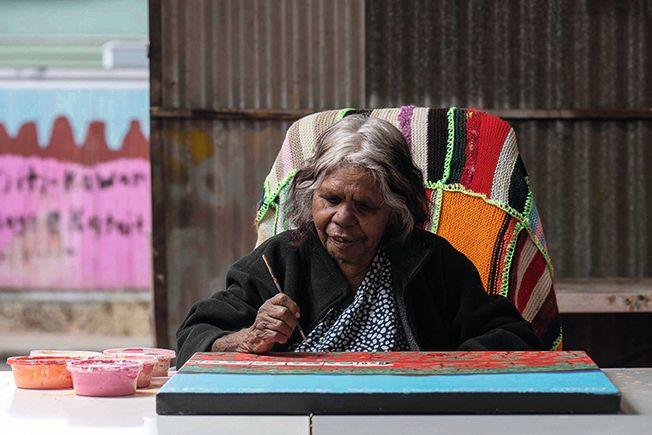On 14 October, Australians will vote in a milestone referendum on whether to change the country’s constitution to recognise Aboriginal and Torres Strait Island people. It is against this heated backdrop that Desert Mob is holding its annual art festival in the central Australian city of Alice Springs (or Mparntwe in the local Arrernte language).
The event (until 22 October) is located more than 2,000 kilometres west of Sydney and is arguably one of the most remote art festivals in the world. Founded in 1991 out of a need for the emerging Aboriginal art sector to address shared interests, Desert Mob this year features an exhibition of more than 280 artists from 35 remote, Aboriginal-governed art centres, a symposium, a market and more.
While Prime Minister Anthony Albanese is calling on the nation to approve the referendum, a divisive ‘No’ campaign has worked to split the vote down familiar political lines. In April the Murdoch-owned newspaper The Australian questioned the authenticity of Aboriginal art produced by APY Art Centre Collective; in July, former Prime Minister Tony Abbot, an outspoken opponent of the referendum, grossly exaggerated the level of government support that Indigenous Australians receive.
Hetti Perkins, the Indigenous curator of Desert Mob, says the remote setting of the festival helps visitors appreciate “the context from which this amazing and diverse culture springs”. She relocated to Alice Springs in 2022 to take up the role with the festival after spending decades working with Central Australian artists, including by curating Fluent, an exhibition at the 47th Venice Biennale that featured work by the late Emily Kame Kngwarreye.

Hetti Perkins, Arrernte, Kalkadoon peoples, Hayley Coulthard, Western Arrarnta people, and Aspen Beattie, Warumungu, Luritja, Yawuru peoples, gathering clay from Salta-Salta Creek at Finke River, Western Aranda Country, 2023
It is not only the collectors and curators who have come from far and wide to attend the festival; many of the artists have travelled for up to three days, enduring flat tires and mechanical trouble to participate. Alice Springs may be remote, but it is a central hub to art centres dotted across more than 2.2 million sq. km of desert.
“For us it’s been the access to the artists,” says Biddy van Annholt, a Melbourne resident and a Desert Mob regular for more than 25 years. Van Annholt and her husband queued for 11 hours to be first into the exhibition on opening day. It “isn’t about being the first to buy the works,” she explains. “We buy through the art centres because it really is grassroots.” The van Annholts had extra motivation to make the journey this year. “Obviously, the voice,” Biddy says, referring to the upcoming referendum.
On the day of the opening Biddy and her husband Chris queued up for 11 hours to be first into the exhibition. It “isn’t about being the first to buy the works,” she tells The Art Newspaper, “we buy through the art centres because it really is grassroots”. This year the van Annholt’s have another reason to be here, “obviously the voice”, she says, referring to the upcoming Australian referendum on an Indigenous voice to parliament.
Inside the exhibition prices range from 275 Australian dollars for Edward Richardson’s Willie #3, a recycled metal bird sculpture, to 60,000 Australian dollars ($37,844) for Warlimpirrnga Tjapaltjarri’s Untitled 2023, a painting of concentric forms resembling a topographic map, that tells the story of the ancestral beings that shaped his country. Nearby Untitled (Marrapinti) 2023 by Yukultji Napangati, who made headlines in 2021 when Beyoncé’s Instagram account shared an image of her work, is listed for $5361.
While strong market interest will see many artists readily uproot to a global art centre, that prospect is inconceivable to Aboriginal artists in remote communities. Art, family and country are indivisible in this region.
Aboriginal communities are often “buffeted by all sorts of political whims”, says Perkins. “But at the end of the day, we focus on the fact that we’ve got decades and decades of long-standing, best-practice Aboriginal governance, and it really does bear fruit at Desert Mob.”

























